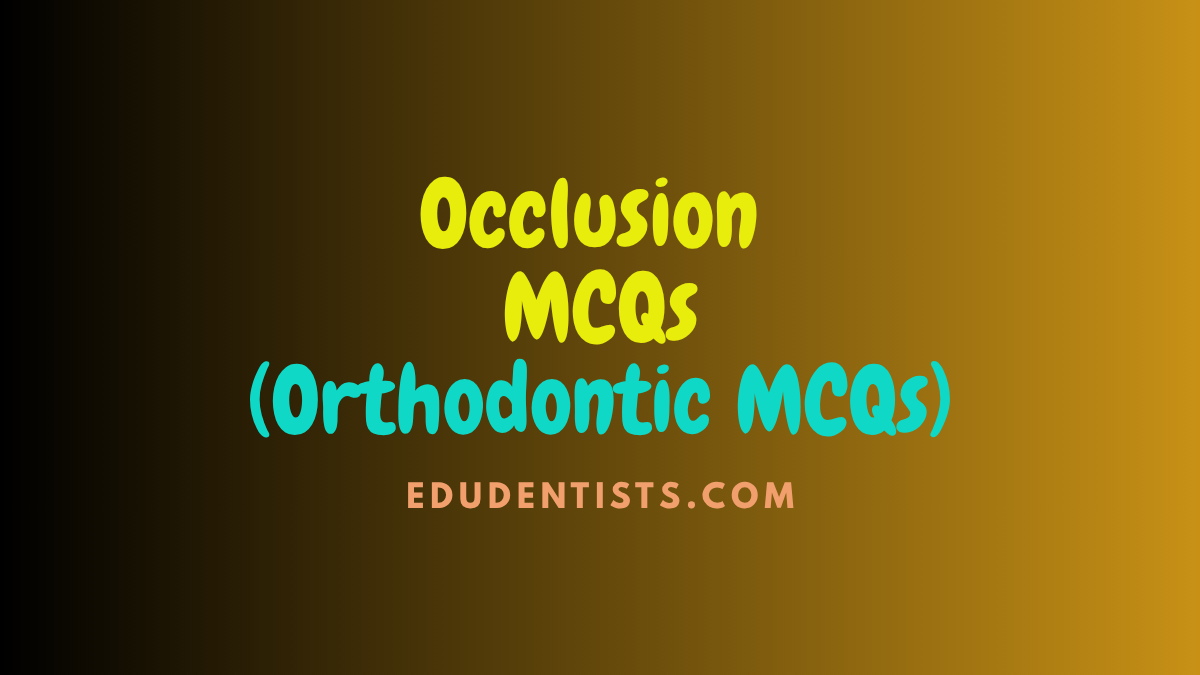Occlusion MCQs
Occlusion MCQs
Occlusion MCQs
- Desmodont is another name for:
A. The tooth with one wall pocket
B. Tooth with three walled pocket
C. periodontal ligament
D. Dehiscence
- Maxillary facial and mandibular lingual cusps require sufficient occlusal length and horizontal overlap for:
A. Esthetics
B. Centric stability
C. Chewing efficiency
D. Soft tissue protection
- Distobuccal cusp of 27 falls into:
A. Embrasure of 37 & 38
B. Embrasure of 36 & 37
C. Mesial pit of 37
D. Immediately incisal to cingulam
- If a permanent first molar is lost, the permanent second molar drifts to the:
A. Buccal side
B. Distal side
C. Mesial side
D. Lingual side
- In an ideal occlusion buccal cusps of maxillary teeth, occlude with:
A. Fossa and rdges
B. Grooves and embrasures
C. Lingual cusps of mandibular teeth
D. Occlusal pits and fissures of mandibular teeth
- Normal dentition in centric occlusion, opposing contact may be expected at:
A. Buccals slopes of buccal cusps of maxillary posterior teeth
B. Buccal slopes of lingual cusps of maxillary posterior teeth
C. Lingual slopes of lingual cusps of mandibular posterior teeth
D. All slopes of lingual cusps of mandibular posterior teeth
- Over jet is defined as:
A. Horizontal overlap
B. Vertical overlap
C. Transverse plane discrepancy
D. All the above
- Group function occlusion is common in:
A. 10 – 14 years
B. 15 -25 years
C. Above 30 years
D. Edentulous patients
- IN occlusion, the teeth have:
A. Cusp – to – cusp contact
B. Edge- to – edge contact
C. Marginal contact
D. Surface – to- surface contact
- Facial occlusal line in the maxillary arch is formed by:
A. Stamp cusps
B. Centric holding cusps
C. Supporting cusps
D. Non- supporting cusps
- Curve passing through the buccal and lingual cusp tips of the mandibular buccal teeth is:
A. Wilson curve
B. Mansoon curve
C. Curve of spee
D. Caternary curve
- In occlusion the teeth have:
A. Cusp to cusp contact
B. Edge to edge contact
C. Marginal contact
D. Surface to surface contact
- Maximum contact between occlusal surfaces, of maxillary and mandibular teeth occur during:
A. Centric occlusion
B. Rest position
C. Protrusive contacts
D. Laterotrusive contacts
- The incisal edges and the incisal thirds of facial surfaces of mandibular incisors and canines generally oppose lingual surfaces of maxillary incisor and canines:
A. Within the incisor thirds
B. At the junction of middle and cervical thirds
C. At the linguo cervical ridges
D. Immediately incisal to cingulam
- The key to occlusion is:
A. Maxillary permanent first molar
B. Maxillary permanent second molar
C. Maxillary primary first molar
D. Maxillary primary second molar
- In the intercuspal position, the lingual cusp of maxillary 2nd premolar contacts the:
A. Distal fossa of mandibular 2ndpremolar
B. Mesial fossa of mandibular 1st molar
C. Distal marginal ridge of mandibular 2ndmolar
D. Distal marginal ridge of mandibular 1st premolar
- In centric occlusion, the cusp tip of the maxillary canine is in alignment with which mandibular tooth?
A. Facial embrasure of canine and premolar
B. incisal embrasure of canine and premolar
C. Distal ridge of the cusp of mandibular canine
D. Mesial ridge on the facial cusp of mandibular first premolar
- When a molar has no opposing tooth, it can become:
A. Extruded
B. Intruded
C. Protruded
D. Retruded
- In normal occlusion , with which grooves / surface of the permanent mandibular first molar does the mesiobuccal cusp of the permanent maxillary first molar occlude:
A. Distobuccal groove
B. Mesial surface
C. Mesiobuccal surface
D. Transverse groove
- The maxillary teeth which have single antagonist are:
A. Lateral incisors
B. Permanent canines
C. Permanent central incisors
D. Third molars
